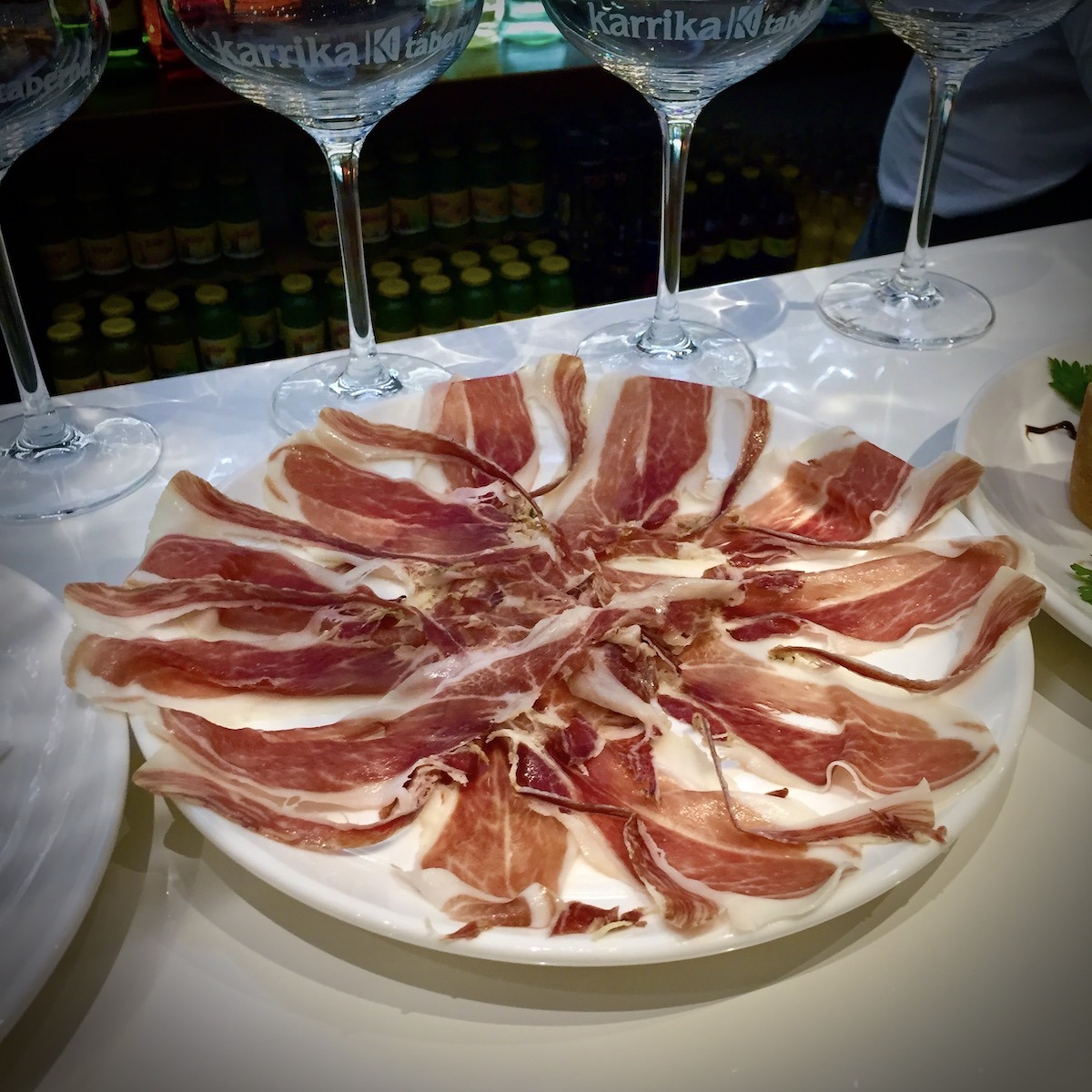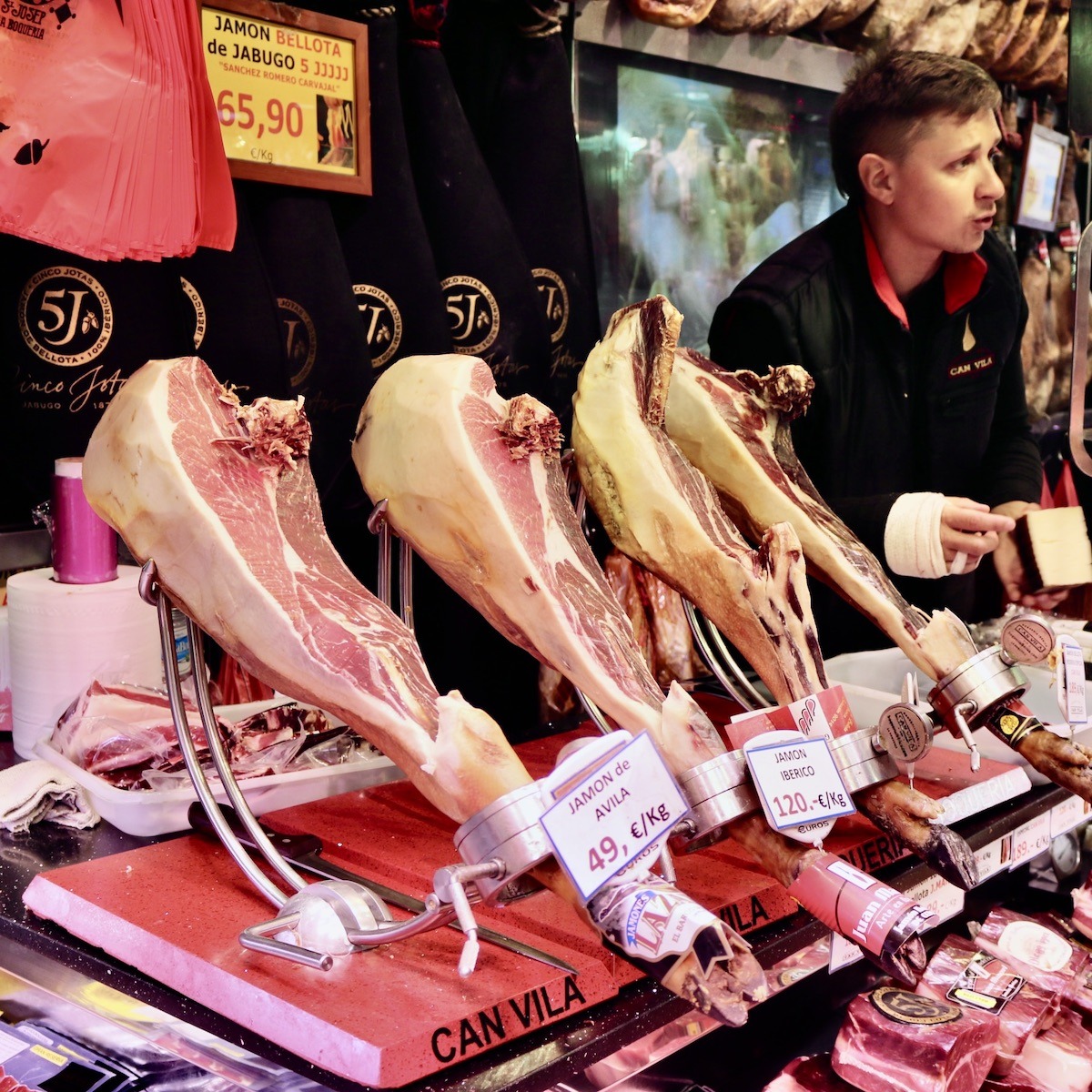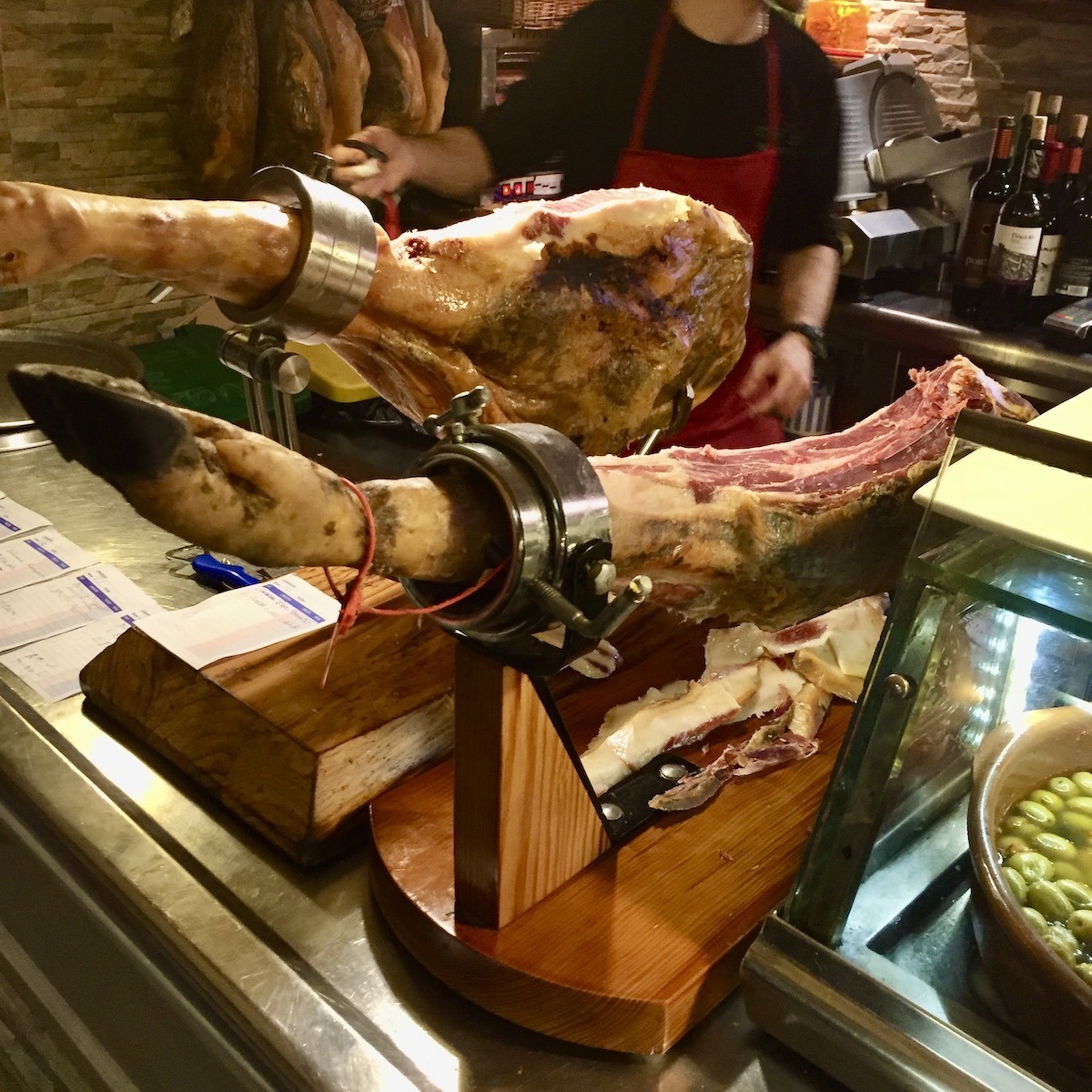

Jamón Ibérico
What Is Jamón Ibérico?
Jamón Ibérico is a type of dry-cured ham that is traditionally produced in Spain. It is made from the hind leg of a white pig that has been salted and air-dried for several months. Jamon serrano is typically cured for 7-18 months, depending on the desired flavor and texture.
The name “serrano” refers to the mountains (Sierra in Spanish) where the ham is traditionally cured, which have a cool, dry climate ideal for curing. The hams are often hung in specially designed curing houses or bodegas, where they are left to dry and develop their distinctive flavor and aroma.
Jamon serrano is a staple of Spanish cuisine and is commonly served as a tapa, or appetizer, along with other cured meats and cheeses. It can also be used in various dishes, from soups and stews to sandwiches and salads. The flavor of jamon serrano is often described as salty and nutty, with a firm texture and a hint of sweetness.
While jamon serrano is typically made from the hind leg of a white pig, some variations use other cuts of meat or different types of pig. For example, some producers make jamon serrano from the pig’s front leg, while others use a mix of white and Iberian pig breeds. However, the traditional method of producing jamon serrano remains the most popular and widely recognized.
How Is It Different From Jamón Serrano?
Both types of cured ham are popular in Spain and beyond. While they may appear similar at first glance, they have several key differences.
- Breed of pig: Jamón ibérico is made from a specific breed of pig, the black Iberian pig, raised exclusively in the Iberian Peninsula. On the other hand, jamón serrano can be made from any breed of pig, although the most common is the white pig.
- Diet: Iberian pigs are known for their unique diet of acorns, which gives the meat a distinct flavor and texture. In contrast, serrano hams are typically made from pigs fed a grain diet.
- Curing time: Jamón ibérico is typically cured longer than jamón serrano, which can take as little as seven months to cure. Jamón ibérico, in contrast, is often cured for 18-36 months, with some producers going as long as 48 months.
- Cost: Due to the higher cost of raising and feeding the Iberian pigs and the longer curing time required for jamón ibérico, it is generally more expensive than jamón serrano.
- Flavor: The distinct diet of the Iberian pig gives jamón ibérico a unique flavor profile often described as nutty, buttery, and complex. Jamón serrano, on the other hand, has a milder, simpler flavor.
Types

Jamon Meats
Several different types of Spanish jamón are distinguished by the breed of pig used, the pig’s diet, and the curing process. Here are some of the most common types of Spanish jamón:
- Jamón ibérico: Made from the black Iberian pig, raised exclusively in the Iberian Peninsula. The pigs are typically fed a diet of acorns, which gives the meat a distinct flavor and texture. Jamón ibérico is often cured for 18-36 months and is considered a premium product due to its high cost and unique flavor.
- Jamón serrano: Made from any pig breed, although the white pig is the most common. The pigs are typically fed a grain diet, and the ham is often cured for 7-18 months. Jamón serrano is a more affordable alternative to jamón ibérico and is popular in Spain and beyond.
- Jamón de bellota: Made from Iberian pigs raised on a diet of acorns. The pigs are free-range and allowed to roam the countryside, which gives the meat a distinct flavor. Jamón de bellota is often cured for 24-36 months and is considered a premium product.
- Jamón de cebo: Made from Iberian pigs raised on a grain and other feed diet. The pigs are often kept in pens and cannot roam free. Jamón de cebo is less expensive than jamón de bellota or jamón ibérico, but still has a rich, savory flavor.
- Jamón de recebo: Made from Iberian pigs raised on a diet of acorns and grain. The pigs are free-range but are also supplemented with feed. Jamón de recebo is a mid-range option in terms of price and flavor.
Jamón ibérico, also known as Iberian ham, is a type of cured ham originating from the Iberian Peninsula, which Spain and Portugal share. The ham is made from the meat of a specific breed of pig called the black Iberian pig, raised exclusively in some areas of Spain.
The Iberian pig is a unique breed well adapted to the Spanish climate and terrain, and it is allowed to roam free and graze on acorns, giving the meat its distinct flavor. The hams are cured for at least 36 months, and the process is a careful and labor-intensive one that involves salting, drying, and smoking the meat.
This process results in a ham rich in flavor and distinctive texture, with the fat content providing a soft, buttery mouthfeel. Jamón ibérico is often served in thin slices as an appetizer or as part of a charcuterie board, and a glass of wine or sherry typically accompanies it.
There are several classifications of jamón ibérico, depending on the quality and type of pig used. The highest quality ham is Jamón Ibérico de Bellota, made from pigs fed on a diet of acorns for several months before being slaughtered. This type of ham is considered a luxury food item and can be expensive.
Jamón ibérico is an integral part of Spanish cuisine and culture, and it is highly prized both within Spain and worldwide. Its unique flavor and texture make it a popular ingredient in various dishes, and its reputation as a luxury item has made it a popular gift for special occasions.
Is it the same as bacon?
Jamón ibérico and bacon are not the same, although they are both made from pork.
Jamón ibérico is a type of cured ham made from the meat of a specific breed of pig called the black Iberian pig, raised in some areas of Spain. The hams are cured for at least 36 months, and the process is a careful and labor-intensive one that involves salting, drying, and smoking the meat. Jamón ibérico has a rich, savory flavor and a soft, buttery texture, and it is typically served in thin slices as an appetizer or as part of a charcuterie board.
On the other hand, Bacon is a type of cured pork made from various cuts of meat, often from the belly of the pig. The meat is cured with salt and other seasonings and then smoked, cooked, or both. Bacon has a salty, smoky flavor and a crispy texture, and it is often served as a breakfast food or used as a flavorful ingredient in various dishes.
While jamón ibérico and bacon are delicious, they are made using different parts of the pig and different curing methods, resulting in distinct flavors and textures.
Is it the same as prosciutto?
Jamón ibérico and prosciutto are both types of cured ham, but they are not the same.
Prosciutto is a type of cured ham from Italy. It is made from the hind leg of a pig that has been salted and aged for anywhere from several months to several years. Prosciutto has a delicate, sweet flavor and a tender, melt-in-your-mouth texture. It is often served in thin slices as an antipasto or flavorful ingredient in various dishes.
While jamón ibérico and prosciutto are cured hams, they come from different regions and are made using different methods, giving them distinct flavors and textures.
What does jamón ibérico taste like?
Jamón ibérico has a rich and complex flavor often described as savory, nutty, and slightly sweet. The taste of jamón ibérico is influenced by several factors, including the breed of pig, the pig’s diet, and the curing process.
The meat of the black Iberian pig, the breed of pig used to make jamón ibérico, has a high-fat content that gives it a soft, buttery texture and a rich, savory flavor. The pigs are often allowed to roam free and graze on acorns, which gives the meat a slightly sweet, nutty taste.
The curing process, which can take up to 36 months or more, also plays a significant role in the flavor of jamón ibérico. During the curing process, the meat is salted, dried, and sometimes smoked, which adds depth and complexity to the flavor.
Food connoisseurs highly prize the taste of jamón ibérico, and it is often considered a delicacy. The combination of its rich, savory flavor, soft texture, and complex aroma make it a favorite among many people.
Why is it so darn expensive?
Jamón ibérico can be expensive due to several factors, including the pig’s breed, diet, and curing process.
The black Iberian pig, the breed of pig used to make jamón ibérico, is a rare and unique breed only found in some areas of Spain. These pigs are raised under strict guidelines and allowed to roam free and feed on a diet of acorns, contributing to the meat’s unique flavor and texture.
The curing process for jamón ibérico is also lengthy and labor-intensive, often taking 36 months or more. This process involves carefully salting, drying, and smoking the meat, which requires significant time and expertise.
Additionally, the highest quality jamón ibérico, known as Jamón Ibérico de Bellota, is made from pigs that have been fed on a diet of acorns for several months before being slaughtered. This type of ham is considered a luxury food item and can be expensive.
All of these factors contribute to the high cost of jamón ibérico. However, this delicacy’s unique flavor and texture are worth the price for many people.
What is its texture?

Jamon Serrano
The texture of jamón ibérico can vary depending on the cut and the curing process, but generally, it is thin and somewhat chewy, with a firm but tender texture. When sliced very thinly, it can almost melt in your mouth, releasing its rich flavor.
The fat in the ham is also an essential part of its texture, with the high levels of unsaturated fat giving the meat a silky mouthfeel. Overall, the texture of jamón ibérico is an integral part of the sensory experience, along with its aroma and flavor.
What is the closest product to it in the United States?
While several types of cured hams are available in the United States, finding a product precisely like jamón ibérico can be difficult. However, some American-made hams have a similar flavor and texture.
One option is prosciutto di Parma, which is a type of cured ham that comes from Italy. Prosciutto di Parma has a similar texture and flavor to jamón ibérico and is often used as a substitute in recipes that call for jamón ibérico.
Another option is a type of American-made cured ham called “country ham,” which is typically made from the hind leg of a pig that has been salt-cured and aged for several months. Country ham has a salty and savory flavor, and its texture can range from firm to tender, depending on the curing process.
While neither of these products is exactly like jamón ibérico, they both have a rich and savory flavor that is similar to jamón ibérico and can be a good alternative for those who want to try something similar.
📖 Recipe
Jamon Iberico with Tomato Bread
A simple recipe for serving Jamon Iberico with tomato bread.
Servings: 2
Ingredients
- 4 slices rustic bread
- 2 cloves garlic
- 1 large tomato ripe
- 6 slices jamón ibérico
- olive oil extra virgin
Instructions
Preheat the oven to 350°F (175°C).
Slice the bread and place it on a baking sheet. Drizzle with olive oil and bake for 10-15 minutes until golden brown.
While the bread is toasting, peel the garlic cloves and cut the tomato in half.
Rub the garlic on the toasted bread, followed by the tomato halves, pressing down to release the juices onto the bread.
Layer the jamón ibérico slices over the tomato bread and drizzle with a bit of olive oil.
Serve immediately and enjoy!
Notes
📖 Recipe
Jamon Iberico with Melon
Wrapping jamón ibérico around melon is a classic Spanish dish that pairs the saltiness of the ham with the sweetness of the fruit.
Ingredients
- 1 ripe cantaloupe or honeydew melon
- 14 thin slices jamón ibérico
- 1 tablespoon fresh lemon juice
- 2 tablespoons olive oil extra-virgin
- black pepper freshly ground
Instructions
Cut the cantaloupe or honeydew melon in half, remove the seeds, and cut into 1-inch thick wedges.
Carefully wrap each melon wedge with 1 or 2 slices of jamón ibérico.
Arrange the wrapped melon slices on a platter.
Whisk the lemon juice and olive oil together in a small bowl, then drizzle the mixture over the melon slices.
Finish with a sprinkle of freshly ground black pepper.
Serve immediately and enjoy!
Notes
This dish makes a refreshing and elegant appetizer or a light summer snack. The combination of the juicy, sweet melon and salty and savory jamón ibérico perfectly matches.
Classic dishes featuring Jamon Iberico?
- Huevos rotos con jamón: This classic Spanish dish consists of fried eggs served over a bed of crispy, fried potatoes and topped with thin slices of jamón ibérico.
- Croquetas de jamón: These are small, deep-fried croquettes that are filled with a creamy mixture of béchamel sauce and chopped jamón ibérico.
- Paella de marisco con jamón: This is a seafood paella that includes diced jamón ibérico in addition to the usual shrimp, clams, and mussels. The jamón adds a depth of flavor to the dish.
- Salmorejo cordobés con jamón: This is a cold soup made with ripe tomatoes, garlic, bread crumbs, and olive oil. It is served with diced jamón ibérico and hard-boiled eggs on top.
- Ensalada de tomate y jamón: This is a simple salad made with ripe tomatoes and thinly sliced jamón ibérico. It is dressed with olive oil and a sprinkle of sea salt.
These are just a few examples of classic Spanish dishes featuring jamón ibérico. Its rich, savory flavor can be used in various dishes to add depth and complexity to the flavor.
 Print
Print




